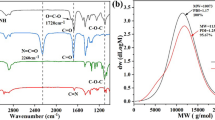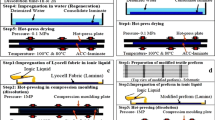Abstract
Lyocell fiber is a low-carbon fiber and has many remarkable characteristics, which makes it a good application prospect in the future. However, lyocell fiber is prone to fibrillate under wet friction conditions. This work aimed to prepare lyocell fabric with low fibrillation tendency by an eco-friendly, low-temperature and efficient crosslinking method. Here, the N1, N6-bis(oxiran-2-ylmethyl)hexane-1,6-diamine crosslinked with lyocell fabric to achieve fibrillation resistance. The dosage of crosslinking agent, pH values of crosslinking solution, temperature, and time on fibrillation tendency of lyocell fabrics were investigated. Scanning electron microscopy was used to observe fibrillation tendency, which showed that the lyocell fabric impregnated in 5% EH and pH = 10 solution at 40 °C for 30 min had almost no microfibrils. In addition, the results showed that the whiteness, mechanical property retained, dyeing performance of crosslinked lyocell fabric did not reduce, and the wear resistance was enhanced. This study demonstrated a potential and practical application of this crosslinking agent to diminish the fibrillation of lyocell fabrics.
Graphical abstract












Similar content being viewed by others
Data availability
All of the data and materials will be made available on request.
References
Babar AA, Peerzada MH, Jhatial AK, Bughio N (2017) Pad ultrasonic batch dyeing of causticized lyocell fabric with reactive dyes. Ultrason Sonochem 34:993–999. https://doi.org/10.1016/j.ultsonch.2016.07.018
Bates I, Ibbett R, Reisel R, Renfrew AHM (2008) Protection of lyocell fibres against fibrillation; influence of dyeing with bis-monochloro-s-triazinyl reactive dyes. Color Technol 124:254–258. https://doi.org/10.1111/j.1478-4408.2008.00149.x
Bediako JK, Wei W, Kim S, Yun YS (2015) Removal of heavy metals from aqueous phases using chemically modified waste Lyocell fiber. J Hazard Mater 299:550–561. https://doi.org/10.1016/j.jhazmat.2015.07.033
Bui HM, Ehrhardt A, Bechtold T (2009) CI Reactive Black 5 dye as a visible crosslinker to improve physical properties of lyocell fabrics. Cellulose 16:27–35. https://doi.org/10.1007/s10570-008-9239-z
Cao M, Liu BW, Zhang L, Peng ZC, Zhang YY, Wang H, Zhao HB, Wang YZ (2021) Fully biomass-based aerogels with ultra-high mechanical modulus, enhanced fame retardancy, and great thermal insulation applications. Compos Part B Eng 225:109309. https://doi.org/10.1016/j.compositesb.2021.109309
Chen JH, Guan Y, Wang K, Xu F, Sun RC (2015a) Regulating effect of hemicelluloses on the preparation and properties of composite Lyocell fibers. Cellulose 22:1505–1516. https://doi.org/10.1007/s10570-015-0608-0
Chen JH, Wang K, Xu F, Sun RC (2015b) Effect of hemicellulose removal on the structural and mechanical properties of regenerated fibers from bamboo. Cellulose 22:63–72. https://doi.org/10.1007/s10570-014-0488-8
Cui S, Zhang Y, Liu C, Lou S, Zhang Y, Zhang Y, Wang H (2021) The influence of the multi-level structure under high drawing on the preparation of high strength Lyocell fiber. Cellulose 29:751–762. https://doi.org/10.1007/s10570-021-04364-x
De Vries TS, Davies DR, Miller MC, Cynecki WA (2014) Kinetics of the cationization of cotton. Ind Eng Chem Res 53:9686–9694. https://doi.org/10.1021/ie500836n
Deng B, Fang L, Fang K, Han X, Liang Y (2023) Scalable preparation of MWCNTs/PAN conductive composite fibers with Tai Chi structure for thermotherapy textiles. Compos Sci Technol 232:109866. https://doi.org/10.1016/j.compscitech.2022.109866
Dhiman G, Chakraborty JN (2017) Assessment of durable press performance of cotton finished with modified DMDHEU and citric acid. Fash Text 4:1–18. https://doi.org/10.1186/s40691-017-0104-2
Fuchs H, Dobson P (2009) Cellulose fiber and method for the production thereof. WO2009155624A1
Goswami P, Blackburn RS, El-Dessouky HM, Taylor J, White P (2009) Effect of sodium hydroxide pre-treatment on the optical and structural properties of lyocell. Eur Polym J 45:455–465. https://doi.org/10.1016/j.eurpolymj.2008.10.030
Guizani C, Nieminen K, Rissanen M, Larkiala S, Hummel M, Sixta H (2020) New insights into the air gap conditioning effects during the dry-jet wet spinning of an ionic liquid-cellulose solution. Cellulose 27:4931–4948. https://doi.org/10.1007/s10570-020-03115-8
Guo X, Wang Y, Ren Y, Liu X (2021) Fabrication of fame retardant lyocell fbers based on carboxymethylation and aluminum ion chelation. Cellulose 28:6679–6698. https://doi.org/10.1007/s10570-021-03931-6
Guo Y, Li C, Li X, Xu H, Chen W, Fang K, Zhang L, Li R, Xie R (2023) Fabrication of superhydrophobic cotton fabric with multiple durability and wearing comfort via an environmentally friendly spraying method. Ind Crop Prod 194:116359. https://doi.org/10.1016/j.indcrop.2023.116359
Ibrahim NA, Eid BM (2016) Potential applications of sustainable polymers in functionalization of cellulosic textile materials. In: Thakur VK, Thakur MK (eds) Handbook of sustainable polymers processing and applications. Pan Stanford, CRC Press, Taylor & Francis Group, USA, pp 215–264
Ibrahim NA, Eid BM (2020) Plasma treatment technology for surface modification and functionalization of cellulosic fabrics. In: Shahid M, Adivarekar R (eds) Advances in functional finishing of textiles. Textile science and clothing technology. Springer, Singapore, pp 275–287
Ibrahim NA, Eid BM, Amin HA (2021) Sustainable textile finishing processes and pollution control based on enzyme technology. In: Ibrahim N, Hussain CM (eds) Green chemistry for sustainable textiles. Woodhead Publishing, Cambridge, pp 385–415
Ji B, Zhao C, Yan K, Sun G (2016) Effects of acid diffusibility and affinity to cellulose on strength loss of polycarboxylic acid crosslinked fabrics. Carbohydr Polym 144:282–288. https://doi.org/10.1016/j.carbpol.2016.02.036
Li XQ, Tang RC (2016) Crosslinking of chitosan fiber by a water-soluble diepoxy crosslinker for enhanced acid resistance and its impact on fiber structures and properties. React Funct Polym 100:116–122. https://doi.org/10.1016/j.reactfunctpolym.2016.01.015
Li M, Liu J, Hu Y, Gao X, Yuan Q, Zhao F (2020) Investigation of the specularite/chlorite separation using chitosan as a novel depressant by direct flotation. Carbohydr Polym 240:116334. https://doi.org/10.1016/j.carbpol.2020.116334
Li Y, Cao C, Feng F, Fang K, Wang M, Xie R, Zhao Z, Chen W (2023) High-performance inkjet printing ink: properties and application effects of vinyl sulfone reactive dye-based inks. J Mol Liq 369:20864. https://doi.org/10.1016/j.molliq.2022.120864
Lim KY, Seong YJ, Kim BC (2003) Reduction of fibrillation of lyocell fiber with cellulose-g-poly(vinyl alcohol) copolymer. Polym J 35:691–696. https://doi.org/10.1295/polymj.35.691
Ma Y, Rissanen M, You X, Moriam K, Hummel M, Sixta H (2020) New method for determining the degree of fibrillation of regenerated cellulose fibres. Cellulose 28:31–44. https://doi.org/10.1007/s10570-020-03513-y
Ma Y, You X, Rissanen M, Schlapp-Hackl I, Sixta H (2021) Sustainable cross-linking of man-made cellulosic fibers with poly(carboxylic acids) for fibrillation control. ACS Sustain Chem Eng 9:16749–16756. https://doi.org/10.1021/acssuschemeng.1c06101
Manian AP, Aldred AK, Lenninger M, Bechtold T (2017) Alkali pretreatments and crosslinking of lyocell fabrics. Cellulose 24:3991–4002. https://doi.org/10.1007/s10570-017-1384-9
Mengal N, Syed U, Malik SA, Sahito IA, Jeong SH (2016) Citric acid based durable and sustainable flame retardant treatment for lyocell fabric. Carbohydr Polym 153:78–88. https://doi.org/10.1016/j.carbpol.2016.07.074
Pethsangave DA, Khose RV, Wadekar PH, Some S (2019) Novel approach toward the synthesis of a phosphorus-functionalized polymer-based graphene composite as an efficient flame retardant. ACS Sustain Chem Eng 7:11745–11753. https://doi.org/10.1021/acssuschemeng.9b01975
Qi H, Huang Y, Ji B, Sun G, Qing FL, Hu C, Yan K (2016) Anti-crease finishing of cotton fabrics based on crosslinking of cellulose with acryloyl malic acid. Carbohydr Polym 135:86–93. https://doi.org/10.1016/j.carbpol.2015.08.014
Shi Y, Li J, Wang Y, Li X, Gao Y, Zhao D, Shi B, Zou L, Song X, Shang Y (2022) A full range experimental study of amplitude- and frequency-dependent characteristics of rubber springs. Polymers 14:4662. https://doi.org/10.3390/polym14214662
Shi L, Fang K, Song Y, Xie R, Xue Z, Li X, Feng B, Xiao Z (2023) Interaction enhancement of lyocell cellulose chains for controlled fibrillation behavior with greener application in eco-textiles. Ind Crop Prod 198:116652. https://doi.org/10.1016/j.indcrop.2023.116652
Tang P, Ji B, Sun G (2016) Whiteness improvement of citric acid arosslinked cotton fabrics: H2O2 bleaching under alkaline condition. Carbohydr Polym 147:139–145. https://doi.org/10.1016/j.carbpol.2016.04.007
Vakili M, Deng S, Li T, Wang W, Wang WJ, Yu G (2018) Novel crosslinked chitosan for enhanced adsorption of hexavalent chromium in acidic solution. Chem Eng J 347:782–790. https://doi.org/10.1016/j.cej.2018.04.181
Wang M, Shi F, Zhao H, Sun F, Fang K, Miao D, Zhao Z, Xie R, Chen W (2022a) The enhancement of wool reactive dyes ink-jet printing through air plasma pretreatment. J Clean Prod 362:132333. https://doi.org/10.1016/j.jclepro.2022.132333
Wang M, Yi N, Fang K, Zhao Z, Xie R, Chen W (2022b) Deep colorful antibacterial wool fabrics by high-efficiency pad dyeing with insoluble curcumin. Chem Eng J 452:139121. https://doi.org/10.1016/j.cej.2022.139121
Wang M, Zhao H, Shi F, Fang K, Liang Y, Xie R, Chen W (2023) Simple surface low temperature grafting for antibacterial and anti-felting inkjet printing wool fabrics. Prog Org Coat. https://doi.org/10.1016/j.porgcoat.2023.107723
Yao W, Wang B, Ye T, Yang Y (2013) Durable press finishing of cotton fabrics with citric acid: enhancement of whiteness and wrinkle recovery by polyol extenders. Ind Eng Chem Res 52:6118–16127. https://doi.org/10.1021/ie402747x
Zhang W, Okubayashi S, Bechtold T (2005a) Fibrillation tendency of cellulosic fibers-part 3. Effects of alkali pretreatment of lyocell fiber. Carbohydr Polym 59:173–179. https://doi.org/10.1016/j.carbpol.2004.09.007
Zhang W, Okubayashi S, Badura W, Bechtold T (2005b) Fibrillation tendency of cellulosic fibers. Part 6: effects of treatments with additive polymers. Appl Polym 101:4140–4147. https://doi.org/10.1002/app.23691
Zhang H, Zhang H, Tong M, Shao H, Hu X (2008) Comparison of the structures and properties of lyocell fibers from high hemicellulose pulp and high α-cellulose pulp. J Appl Polym Sci 107:636–641. https://doi.org/10.1002/app.27129
Zhang LS, Liu HL, Yu WD (2015) Effect of air plasma treatment on the dyeing of Tencel fabric with C.I. Reactive Black 5. Appl Surf Sci 328:501–508. https://doi.org/10.1016/j.apsusc.2014.12.073
Zhang Y, Fang K, Wang W, Niu H (2022) A water-soluble epoxy-based green crosslinking system for stabilizing PVA nanofibers. Molecules 27:4177. https://doi.org/10.3390/molecules27134177
Zhang L, Zheng Q, Ge X, Chan H, Zhang G, Fang K, Liang Y (2023a) Preparation of Nylon-6 micro-nanofiber composite membranes with 3D uniform gradient structure for high-efficiency air filtration of ultrafine particles. Sep Purif Technol 308:122921. https://doi.org/10.1016/j.seppur.2022.122921
Zhang S, Ren Y, Zhao H, Han L, Yang G, Liu Y, Fang K (2023b) Short wet-steaming low-carbon cleaner pad dyeing of cotton/polyamide/lyocell fabric with reactive dyes. Ind Crop Prod 197:116556. https://doi.org/10.1016/j.indcrop.2023.116556
Zhou T, Xu H, Cai L, Wang J (2020) Construction of anti-flame network structures in cotton fabrics with pentaerythritol phosphate urea salt and nano SiO2. Appl Surf Sci 507:145175. https://doi.org/10.1016/j.apsusc.2019.145175
Zhu P, Liu JY (2018) Preparation and properties of cross-linked regenerated cellulose fibers. J Text Sci Eng 8:1–5. https://doi.org/10.4172/2165-8064.1000354
Acknowledgments
The authors gratefully acknowledge the financial support from the Fundings.
Funding
This work was supported by (1) Shandong Province Key Technology R&D Program for Middle and Small Enterprises, Grant No. 2021TSGC1189; (2) Shandong Province Key Technology R&D Program, Grant No. 2023CXGC010612, 2023CXGC010504, and 2023CXPT022; (3) State Key Laboratory for Biofibers and Eco-textiles, Grant No. ZDKT202008, ZDKT202103 and ZKT33; (4) Shandong Province Department of Science and Technology, Grant No. ZR2020QE099.
Author information
Authors and Affiliations
Contributions
XL: conceptualization, methodology, validation, data curation, writing – original draft, writing—review and editing. KF: supervision, project administration, funding acquisition. LS: writing—original draft preparation, validation, supervision. ZX: software, investigation supervision. BF: validation. QZ: data curation. ZX: conceptualization. RX: supervision, project administration, funding acquisition.
Corresponding authors
Ethics declarations
Conflict of interest
The authors declare that they have no known competing financial interests or personal relationships that could have appeared to influence the work reported in this paper.
Ethical approval
All authors state that they adhere to the Ethical Responsibilities of Authors. In addition, the work is compliance with ethical standards.
Consent for publication
All authors listed in this article agree to be published.
Additional information
Publisher's Note
Springer Nature remains neutral with regard to jurisdictional claims in published maps and institutional affiliations.
Rights and permissions
Springer Nature or its licensor (e.g. a society or other partner) holds exclusive rights to this article under a publishing agreement with the author(s) or other rightsholder(s); author self-archiving of the accepted manuscript version of this article is solely governed by the terms of such publishing agreement and applicable law.
About this article
Cite this article
Li, X., Fang, K., Shi, L. et al. Low-temperature and efficient crosslinking of lyocell knitted fabric with an eco-friendly diepoxy agent for fibrillation resistance. Cellulose 31, 717–735 (2024). https://doi.org/10.1007/s10570-023-05618-6
Received:
Accepted:
Published:
Issue Date:
DOI: https://doi.org/10.1007/s10570-023-05618-6




